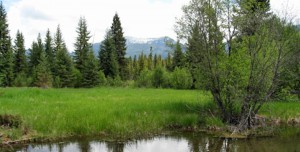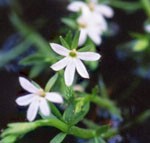Swan Lake
Lesson Cornerstone:
Riparian ecology, including rare plants; old-growth forests
Curriculum Content Standards: Science
(3) Students, through the inquiry process, demonstrate knowledge of characteristics, structures and function  of living things, the process and diversity of life, and how living organisms interact with each other and their environment.
of living things, the process and diversity of life, and how living organisms interact with each other and their environment.
Site Description:
The Swan River Oxbow Preserve derives its name from a long, curving oxbow in which the Swan River used to flow. The variety of wetland communities create a haven for birds and harbor five rare plant populations and two rare lichens. Spruce forest predominates along the southern boundary. A complex of sedge fen and birch carr communities lie adjacent to the spring system. To the west, cottonwood forest dominates the area around the aquatic oxbow.
The water howellia is federally listed as threatened. On the preserve, howellia grows in the marshy areas next to the oxbow. An annual plant with white flowers, howellia requires a delicate balance of conditions for its survival. The plant must be submerged in water to grow and reproduce. Its seed won’t germinate under water, so howellia must grow in ponds that are flooded in spring, and dry by late summer or fall. If conditions are too wet, the seeds will not germinate. In drought conditions, the plant won’t grow.
Trails and Terrain:
All trails are signed. The trail is 1.5 miles to the overlook at the Oxbow, one-way. The terrain is flat.
Wildlife Present:
Grizzly bears use the preserve as a corridor between mountain ranges and feed on native fruits, such as huckleberries and herbaceous plants in the area. Bald eagles and osprey roost in the trees and feed along the river. Elk, moose and white-tailed deer may also be found on the preserve.
Various riparian birds are drawn to the water systems of the preserve, including the common loon, mallard, cinnamon teal, ring-necked duck, common goldeneye and spotted sandpiper.
On-Site Educational Programs:
There is a large kiosk at the trailhead with interpretative material and plant identification tags along the trail.
Seasons:
Spring, summer and fall.
Access:
Swan River Oxbow Preserve is accessed from the parking area.
There is no official ADA access.
Parking and Entrance to Site:
North of mile post 68 on the Swan Highway, Montana Highway 83, is Porcupine Creek Road. Turn west. Travel about .5 mile to first gravel road to the north. This leads to the parking area.
There is a parking area.
Google Earth Driving Directions:
Group size limits:
None.
Fees:
None.
Restrictions:
Only foot travel is allowed. Hunting and camping are not permitted.
Other Suggestions:
Rubber boots in the spring (May and June) and mosquito repellant are suggested.
Site services:
No facilities. Swan Lake is located about 3 miles away.
Contact Information:
The Nature Conservancy, 443-0303.